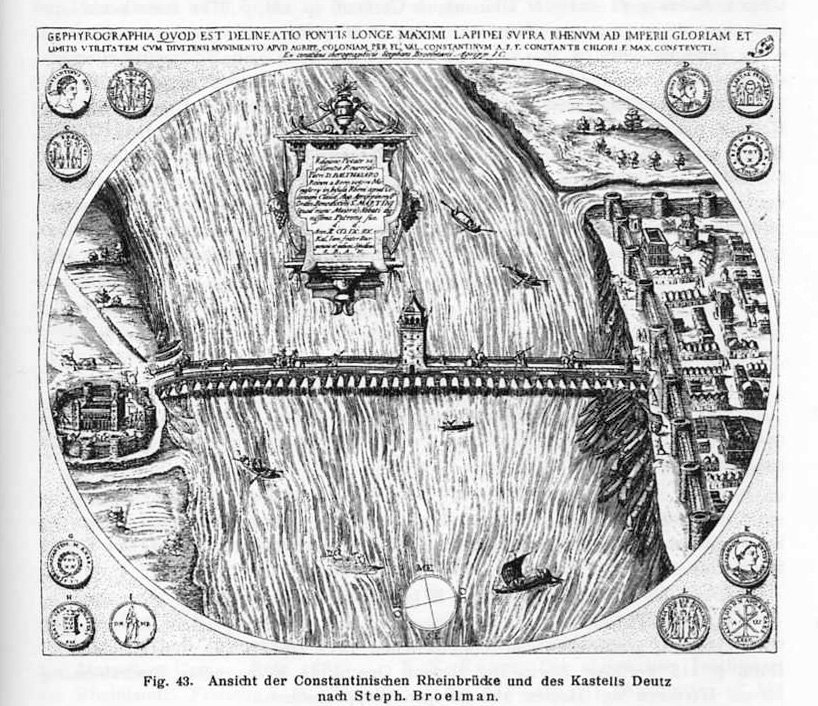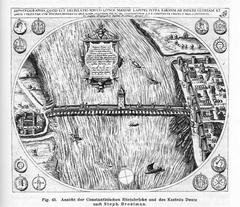
Castra Divitia (Fort Deutz), Cologne: Complete Visitor Guide, Tickets, Hours, and Historical Insights
Date: 14/06/2025
Introduction
Located on Cologne’s eastern bank of the Rhine in the Deutz district, Castra Divitia (also known as Kastell Divitia or Fort Deutz) stands as a striking testament to the strategic genius of the Roman Empire and its lasting influence on European urban development. Built in the early 4th century CE under Emperor Constantine the Great, this Roman fortress was crucial in defending the river crossing opposite Colonia Claudia Ara Agrippinensium (modern Cologne). As a key element of the Lower Germanic Limes—a frontier defense system now recognized as a UNESCO World Heritage Site—Castra Divitia protected Roman territories, fostered economic growth, and facilitated cultural exchange. Today, visitors can explore its remains, which are thoughtfully woven into Cologne’s contemporary cityscape, offering a window into the city’s Roman roots and its evolving identity (fotoeins.com; cologne-tourism.com; archaeology-travel.com).
This detailed guide covers Castra Divitia’s history, architectural features, strategic significance, and provides practical visitor information—covering hours, tickets, accessibility, nearby attractions, and travel tips. Whether you are a passionate historian or a casual traveler, discover how Castra Divitia bridges ancient heritage and 21st-century urban life.
Table of Contents
- Origins and Evolution of Roman Castra
- Strategic Role of Castra Divitia
- Architectural Features and Site Layout
- Garrison and Military Operations
- Economic and Cultural Impact
- Decline and Legacy
- Practical Visitor Information
- Archaeological Features and Discoveries
- Cultural and Historical Significance
- Visitor Experience and Exploration
- Historical Continuity and Urban Memory
- UNESCO World Heritage and Urban Planning
- Frequently Asked Questions (FAQ)
- Visuals, Media, and Further Reading
1. Origins and Evolution of Roman Castra
Roman castra (military camps or forts) were foundational to the empire’s military operations and frontier control. Initially erected as temporary earth-and-wood camps during campaigns, these structures became permanent stone fortifications by the late 1st century CE, reflecting Rome’s shift from conquest to defense (x-legio.com). The systematic design—a rectangular plan with grid-patterned streets, defensive ramparts, and standardized buildings—enabled rapid construction and efficient defense.
2. Strategic Role of Castra Divitia
Castra Divitia was built between 310 and 315 CE to safeguard the crucial Rhine crossing and the newly constructed stone bridge, anchoring Roman power on both sides of the river (legionaryfortresses.info). The fort protected Colonia Claudia Ara Agrippinensium (Cologne) from Germanic incursions and served as a base for military operations, logistics, and regional administration. Its establishment marked the first permanent Roman settlement on the right bank of the Rhine—a major step in Cologne’s urban expansion (nrw-tourism.com).
3. Architectural Features and Site Layout
Castra Divitia’s design embodied the principles of Roman military engineering. The rectangular walled enclosure featured robust stone walls, corner towers, and strategically placed gates (notably the Osttor/East Gate). Within the walls, standard buildings included the principia (headquarters), barracks, granaries, workshops, and stables (unrv.com). Archaeological excavations have revealed substantial remains of these features, and a bronze model and site markers on the Rheinboulevard help visitors visualize the original layout (roemisch-germanisches-museum.de).
4. Garrison and Military Operations
The fort typically housed several hundred to a few thousand troops: legionaries and auxiliary units who patrolled the frontier, manned the bridge, and responded to threats. Castra Divitia’s role shifted over time, serving as a staging ground for campaigns and a bulwark during periods of instability. The military presence stimulated local economic activity and contributed to the spread of Roman law, language, and customs (unrv.com).
5. Economic and Cultural Impact
Permanent military installations like Castra Divitia attracted merchants, artisans, and families, spurring the growth of civilian settlements (vici) around the fort. These communities often adopted Roman lifestyles, furthering the process of Romanization in the region. Over centuries, such settlements often evolved into thriving urban centers—a process mirrored in Cologne’s own development (x-legio.com).
6. Decline and Legacy
By the late 4th and 5th centuries, the Roman frontier system weakened due to internal strife and external pressures. The fort at Divitia fell into disuse, with some of its stones repurposed in later buildings (e.g., St. Pantaleon church). However, the Roman urban grid and infrastructure continued to shape Cologne’s development for centuries (koeln-lotse.de). Today, Castra Divitia’s remains are preserved as part of the UNESCO-listed Lower Germanic Limes.
7. Practical Visitor Information
Visiting Hours and Tickets
- Open-Air Site Access: Castra Divitia is an open archaeological site in the Rheinboulevard and Historischer Park Deutz. It is accessible 24/7, free of charge.
- Guided Tours and Special Events: Scheduled tours and events (e.g., Roman reenactments) are available through local heritage organizations—check KölnTourismus and Historischer Park Deutz for up-to-date information.
- Museum Tickets: Artifacts from Castra Divitia are displayed at the Römisch-Germanisches Museum (standard entry fees apply; check roemisch-germanisches-museum.de for times and prices).
Accessibility
- Mobility: The site features level, paved areas suitable for wheelchairs and strollers, though some uneven surfaces remain.
- Restrooms and Amenities: There are no on-site restrooms; nearby facilities are available in Deutz.
- Getting There: Castra Divitia is easily reached via public transport (Deutz/Messe station) and is a short walk from the city center across the Hohenzollern Bridge.
Nearby Attractions and Travel Tips
- Cologne Cathedral (Kölner Dom): A UNESCO World Heritage Site and iconic Gothic masterpiece.
- Roman-Germanic Museum: Displays artifacts from Castra Divitia and Roman Cologne.
- Old Town (Altstadt): Rich in history, restaurants, and shopping.
- Best Time to Visit: Spring and autumn for mild weather and fewer crowds (Destination Abroad).
8. Archaeological Features and Discoveries
Structural Remains
The most visible features are parts of the ancient walls, the partially reconstructed East Gate, and the “Schinkenkessel” northwest tower, integrated into modern infrastructure. Site markers and a bronze model help interpret the original fort’s scale (travelwriticus.com).
Artifacts
Excavations have uncovered ceramics, coins, weaponry, and imported goods, painting a vivid picture of life at the frontier. Many finds are exhibited in the Römisch-Germanisches Museum.
Interpretation
Interpretive panels in German and English, and occasional guided tours, provide historical context. Digital resources and QR codes on-site link to further information.
9. Cultural and Historical Significance
UNESCO World Heritage
Castra Divitia’s inclusion in the Lower Germanic Limes UNESCO World Heritage listing in 2021 underscores its exceptional value as a cultural and historical landmark (nrw-tourism.com). It highlights the role of Roman frontier policy, military engineering, and cross-cultural interaction.
Urban Influence
The fort’s presence shaped the Deutz district and influenced Cologne’s city planning for centuries. The site’s layered history—from Roman fort to Frankish royal court, monastery, and Prussian barracks—reflects Cologne’s adaptability and resilience (thehistoryofcologne.com).
10. Visitor Experience and Exploration
- Atmosphere: The open-air site blends ancient ruins with modern riverside promenades, offering panoramic city skyline views.
- Photography: Permitted and encouraged; best lighting in early morning or late afternoon.
- Duration: 30–60 minutes is recommended; more if combining with museums or other Roman sites.
- Etiquette: Respect the ruins—do not climb or remove materials.
11. Historical Continuity and Urban Memory
Castra Divitia’s foundation marked the beginning of permanent settlement on the Rhine’s right bank. The name “Divitia” evolved linguistically into “Deutz” and “Düx,” reflecting its enduring place in Cologne’s identity (de.wikipedia.org).
12. UNESCO World Heritage and Urban Planning
The fort’s recognition by UNESCO has led to increased preservation efforts and public engagement. The Historischer Park Deutz, supported by local associations, ensures ongoing stewardship, education, and accessibility (koeln-lotse.de).
13. Frequently Asked Questions (FAQ)
Q: What are Castra Divitia’s visiting hours?
A: The open-air site is accessible at any time; museum and guided tour hours vary.
Q: Is there an entrance fee?
A: No, access to the fort remains is free. Museum visits and some tours may require tickets.
Q: Are guided tours available?
A: Yes, through local organizations—check official channels for schedules.
Q: Is the site accessible for wheelchairs?
A: Yes, with mostly level surfaces and paved paths.
Q: How do I reach Castra Divitia?
A: Via Deutz/Messe station (train, tram) or a short walk from central Cologne.
Q: What else can I see nearby?
A: Cologne Cathedral, Roman-Germanic Museum, Old Town, Museum Ludwig.
14. Visuals, Media, and Further Reading
- Images and virtual tours are available on Cologne Tourism and Römisch-Germanisches Museum.
- Bronze models and site markers on-site help visualize the fort’s original layout.
Final Tips
Castra Divitia is an exceptional example of Roman military engineering and its enduring impact on Cologne’s urban and cultural fabric. With free, open-air access year-round, thoughtful interpretation, and proximity to major attractions, it is an essential stop for history lovers and curious travelers alike. Plan your visit during spring or autumn for optimal weather, respect the site’s heritage, and consider combining your exploration with other Roman sites for a comprehensive experience (nrw-tourism.com; koeln-lotse.de; cologne-tourism.com).
References
- x-legio.com
- cologne-tourism.com
- fotoeins.com
- nrw-tourism.com
- KölnTourismus
- destinationabroad.co.uk
- archaeology-travel.com
- koeln-lotse.de
- roemisch-germanisches-museum.de
Plan your visit to Castra Divitia and discover Cologne’s extraordinary Roman legacy. Download the Audiala app for guided tours, follow our social channels for updates, and explore more in-depth articles on Cologne’s ancient sites.






































































